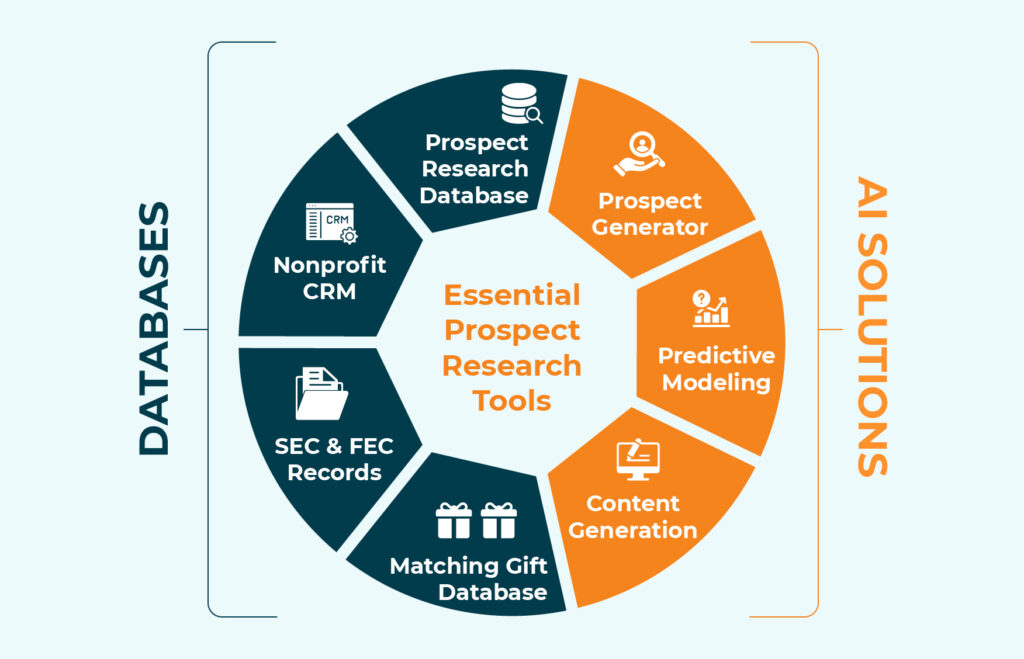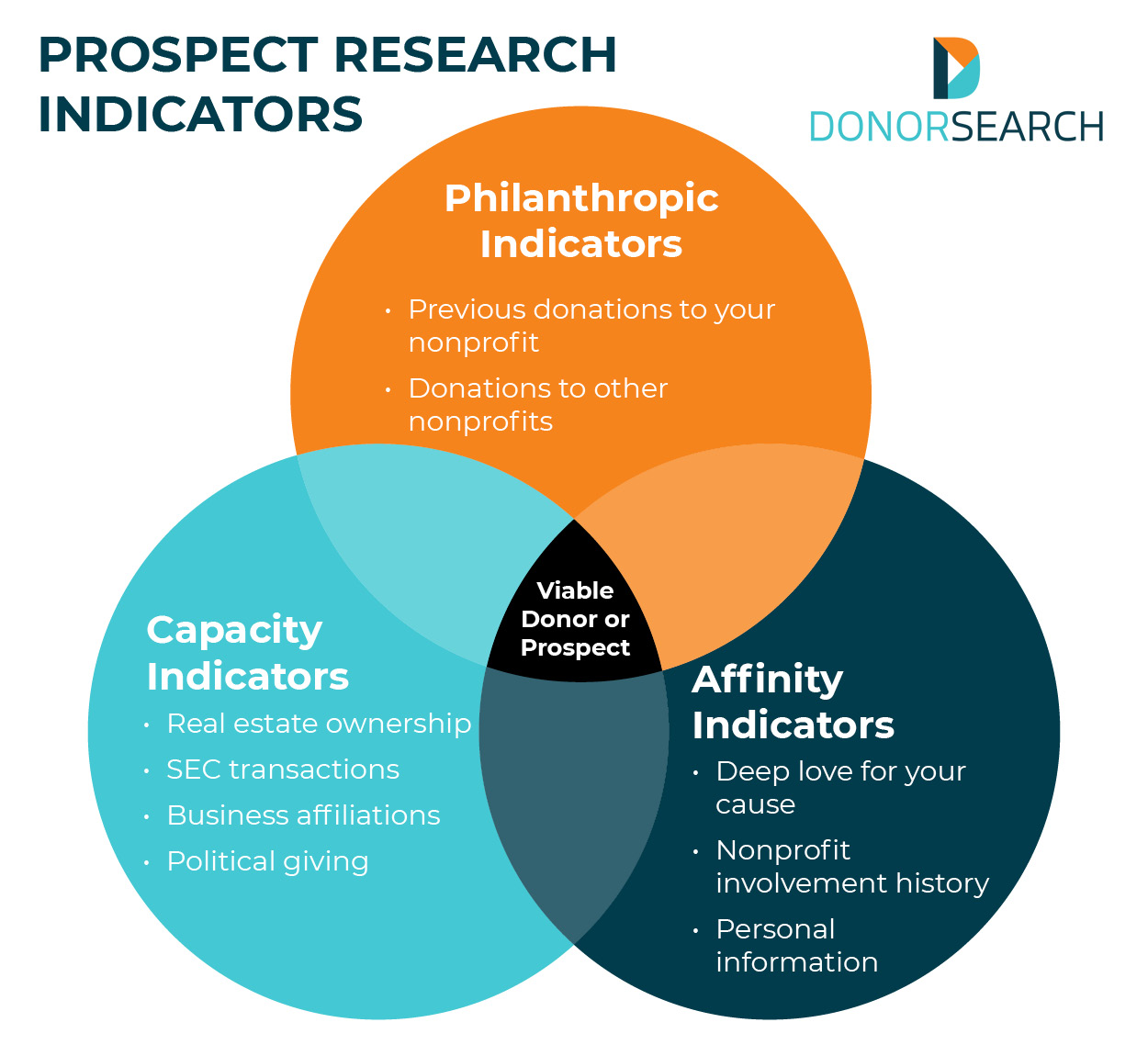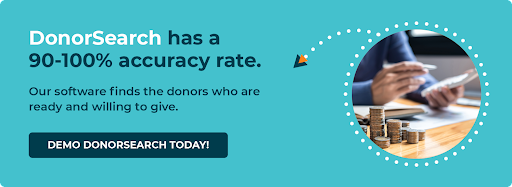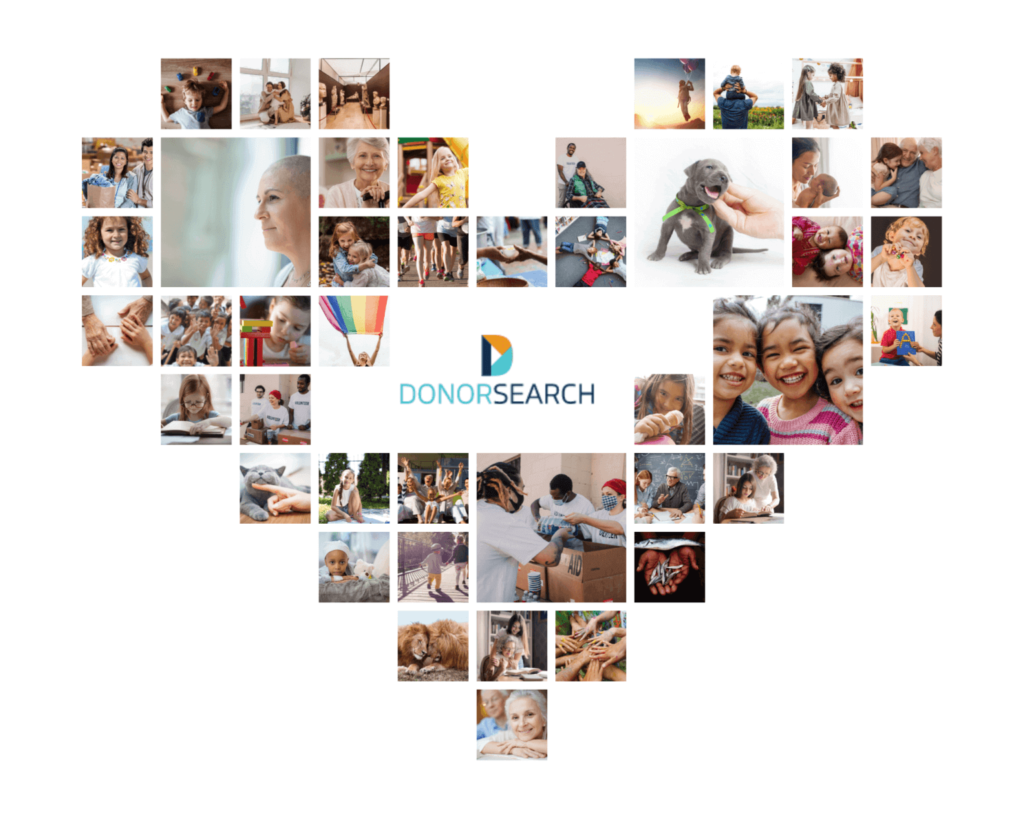For your nonprofit to further its mission and make a positive impact on its community, it’s critical to develop effective community engagement and revenue generation strategies that empower you to cultivate strong relationships with current and new donors. One of the most effective ways to improve your fundraising efforts and achieve these goals is to conduct thorough prospect research.
If you’re brand-new to prospect research or need a refresher on the process, you’ve come to the right place! This crash course will provide a comprehensive overview of prospect research and explain the steps your nonprofit should take to get started.

Screen prospects quickly to get the freshest insights possible. Explore the tools DonorSearch has to help you get ahead!
Donor Prospect Research FAQ
Especially if you’re conducting prospect research for the first time at a smaller or newer organization, you likely have questions about the process. Let’s begin by answering some of the most frequently asked questions that arise when jumping into donor prospecting.
What is prospect research?
Prospect research is a technique used by nonprofit fundraisers, major gift officers, and development teams to identify high-impact donors within and beyond an organization’s current donor pool. Through this process, nonprofits gather an immense amount of data—information about donors’ backgrounds, past giving histories, wealth indicators, philanthropic motivations, and more details that help determine prospects’ likelihood of giving.
(Note that prospect research may also be referred to as donor prospecting, screening, or donor research.)
How does prospect research differ from wealth screening?
When learning about prospect research, you may come across the term “wealth screening.”
Traditional wealth screening falls under the “prospect research” umbrella. It typically focuses on analyzing current and prospective donors’ wealth markers, such as real estate ownership, business affiliations, and stock holdings. These help your organization determine a donor’s financial giving capacity.
However, just because a donor has the capacity to make a significant gift to your organization doesn’t necessarily mean they’d be willing to do so. Prospect research that takes into account a donor’s philanthropic tendencies and affinity for your mission provides a fuller picture of potential donors than wealth details alone.
What misconceptions exist around prospect research?
Besides conflating prospect research and wealth screening, one of the most common misconceptions around prospect research is that nonprofits use it just to identify new donors when planning a campaign or initiative. In reality, prospect research should be an ongoing process, used not only for new donor identification but also for:
- Learning more about the existing supporters in your donor database.
- Staying up-to-date on prospects’ wealth and philanthropic details throughout the cultivation process.
- Developing data-driven donor stewardship and retention strategies after a prospect has converted.
Additionally, while prospect research lays the foundation for donor engagement, it doesn’t take the place of human-centered relationship-building. Use the information you gather through screening to outline tailored outreach and cultivation strategies, then get to know each prospect personally so you can create an individualized engagement plan and make a fundraising ask they’ll be receptive to.
What types of organizations use prospect research?
Many different organizations can benefit from incorporating prospect research into their fundraising efforts, including:
- K-12 Schools: Consider screening parents and families of students to see how much they could contribute to various giving campaigns throughout the school year.
- Colleges, Universities, and Sororities and Fraternities: Prospect research allows for more effective segmentation of potential donors—especially alumni—which results in more targeted and successful solicitation efforts.
- Healthcare Organizations: Early and frequent research can help grow grateful patient donor programs.
- Advocacy and Social Service Organizations: Large volunteer pools and event attendee lists mean there are always new prospects to screen and analyze for future giving potential.
- Arts and Culture Organizations: Screening single-ticket purchasers, special event attendees, members, and consistent donors can lead to more support.
- Environmental Groups: With a calendar full of events and volunteer activities, these organizations should screen attendees for more targeted donor cultivation.
- Faith-Based Organizations: Churches, mosques, synagogues, and other places of worship can pinpoint parishioners or frequent service attendees who could contribute significant gifts.
What areas of nonprofit fundraising is prospect research used for?
Prospect research is most useful for finding potential donors who could contribute significant gifts, since converting them requires more tailored efforts than lower-level supporters. These include supporters who give:
- Major gifts—the largest individual contributions your organization receives, which are essential for funding many mission-critical initiatives.
- Capital campaign donations, particularly during the quiet phase where you’ll solicit a set amount of major gifts.
- Annual fund contributions—both so you can secure the 60% of annual funding that comes from major gifts and so you know which annual donors you can ask to upgrade their support each year.
- Planned gifts such as bequests (which are growing in popularity!), charitable gift annuities, and charitable remainder trusts.
What are the benefits of prospect research?
Prospect research can enrich your nonprofit’s operations in a myriad of ways, allowing you to:
- Refine your major donor fundraising strategy: Prospecting saves you time and money by helping you focus your efforts on the prospects who are most likely to give. Plus, by screening both new and existing supporters, you can expand your reach while realizing the untapped potential in your current donor base.
- Optimize ongoing fundraising activities: With a wealth of data at your fingertips, your organization can discover trends in its fundraising efforts and refine its goals and strategies for the future.
- Identify corporate giving opportunities: You might find out if your donors are eligible for corporate giving programs like matching gifts or volunteer grants as you gather information about donors’ employment, giving history, and nonprofit involvement.
- Fill gaps in donor data: Donors may move, get married, or change their phone numbers. Prospect research can help you update inaccurate or out-of-date information so you can always stay in touch with your supporters.
The Elements of Prospect Research
To successfully conduct prospect research for your nonprofit, you’ll need a solid understanding of its key elements—the screening tools you’ll use and the indicators you’ll look for in the data you gather. Let’s explore each of these elements.
Prospect Research Tools You’ll Need
Like most contemporary fundraising processes, successful prospect research starts with the right software. Ensure your organization has the following solutions in its tech stack before you begin:

-
Prospect research database
A comprehensive database such as DonorSearch’s top-of-the-line solution will inform your organization about prospects’ charitable giving, business connections, real estate ownership, stock holdings, corporate giving opportunities, and more.
-
Your nonprofit's CRM
Your internal database can be a starting point for learning more about current donors and their connections to new prospects, as well as identifying potential major donors within your existing supporter base.
-
SEC investment records and FEC political contribution records
These government records can supplement your prospect research data to show you which prospects or donors have the capacity and propensity to give a large gift.
-
Prospect generator solutions
A prospect generator like DonorSearch’s ProspectView Online 2 (PVO2) can provide you with lists of prospects who have supported causes similar to yours, as well as AI-powered prospect reports that summarize essential, actionable information about potential donors.
-
Predictive modeling solution
These AI tools (including DonorSearch Ai and Enhanced CORE, the most advanced machine learning solutions for nonprofits) organize your prospect lists and make suggestions about which donors to reach out to first so you can improve results while saving time and resources.
-
Generative AI communication tool
Nonprofit-specific generative AI tools (particularly DonorSearch Ai + Momentum) use predictive modeling insights to inform content creation so you can reach out to your top prospects more efficiently and effectively.
-
Matching gifts database
A matching gifts database lets you know which donors and prospects can request donation matches from their employers, providing insights into their professional connections and pointing out opportunities to bring in additional revenue through corporate philanthropy.
In addition to these tools, simple internet searches and deep dives into prospects’ social media profiles (such as LinkedIn, Facebook, and Instagram) can help reveal who your donors are and what they value.
Discover how DonorSearch’s wealth and philanthropic screening tools, PVO2, DonorSearch Ai, Enhanced CORE, and our partnership with Momentum can help your nonprofit learn about potential donors in detail!
Prospect Research Indicators to Know
During the prospect research process, you’ll be looking for three kinds of indicators (or markers) for each potential donor: capacity (wealth) indicators, philanthropic indicators, and affinity (warmth) indicators. Let’s dig into each category in more detail.

Capacity Indicators
These indicators help you know whether a donor or prospect is in a financial position to give a large gift, and can assist you when determining how much to ask for down the line. Here are a few examples of wealth indicators:
-
real estate ownership
Individuals who own real estate valued at $2+ million are 17 times more likely to give philanthropically than the average person. More generally, knowing about the property a prospect owns can help you make inferences about their finances.
-
SEC transactions
Stock holdings at publicly-traded companies are reported to the U.S. Securities and Exchange Commission (SEC), and these records are publicly accessible through SEC.gov. They provide a clear window into a key aspect of a donor’s finances.
-
business affiliations
These connections can tell you about a donor’s career and professional life—and by extension, their financial situation.
-
political giving
Someone who has donated significant amounts of money to political campaigns has the financial capacity to make a major gift. Plus, you may find that a prospect’s political leanings give them a greater affinity for your mission.
Philanthropic Indicators
These indicators show that a donor or prospect may be willing to contribute to your organization because they have philanthropic tendencies. The two main philanthropic markers are:
-
previous donations to your nonprofit
Past giving is one of the clearest signs that a prospect is willing to give again, and they may even upgrade their support as their relationship with your organization grows.
-
donations to other nonprofits
If a donor has given to other nonprofits, it’s a solid indication of charitable habits, especially if these organizations have similar missions to yours. Reference other nonprofits’ annual reports and recognition records to find this information.
Affinity Indicators
These markers indicate that a donor or prospect may be willing to give to your organization because they’re passionate about your specific work. Some examples include:
-
deep love for your cause
Whether they care about your nonprofit’s mission because they’re a grateful recipient of your services or simply because they’re passionate about your vision for a brighter future, strong connections to your cause let you know that a donor or prospect may say “Yes!” to a donation request.
-
nonprofit involvement history
Donors who truly value philanthropy and your organization's mission often give back in non-monetary ways as well—whether by volunteering, making in-kind donations, attending fundraising events, serving on your board, or advocating for your cause in the community. Keep an eye out for prospects who have also engaged with other similar nonprofits in these ways.
-
personal information
This category includes prospects’ demographic details, hobbies, interests, values, family ties, and other aspects of their background, which can all influence their philanthropic decision-making.
Remember that in thorough prospect research, you can only say you’ve found a viable prospect if they exhibit all three types of indicators. The greater these markers are in quantity and quality, the higher priority the prospect should be on your outreach list.
Popular Approaches to Donor Prospecting
You have a few different options when it comes to how you conduct prospect research. Let’s look at each approach and why your organization might choose it.
1. Conducting In-House Prospect Research
If your nonprofit is just starting out or if you have a tight budget, you may have an existing staff member (usually someone from your development team) take responsibility for prospecting. Although this likely won’t be a sustainable long-term solution as your organization grows, it’s an accessible way to begin prospect research so you can kickstart your nonprofit’s growth. To assist with this DIY approach, there are plenty of great resources (guides, classes, webinars, etc.) available through popular prospect research channels.
The other way to conduct prospecting in-house is to hand the job over to full-time research staff. Building a research team will likely be helpful if you have a large prospect pool and need to free up other staff members’ time.
Start by hiring one employee to lead your research efforts, then expand the team as your nonprofit’s needs grow. Look for candidates who have strong analysis skills, experience in fundraising and working with databases, and the ability to synthesize data.
2. Working With a Prospect Research Consultant
Another option for conducting prospect research (especially if you don’t want to eat up your staff’s limited time and energy) is to hire a prospect research consultant. If you’re interested in working with one of these experts, ask yourself the following questions:
- What are you looking to gain? If you know what goals you want to accomplish through the partnership, you’ll be able to go into the consultant hiring process fully aware of your organization’s needs and find the right partner to fulfill those needs.
- What kind of access do you need to your consultant? Decide whether you need a consultant who will be available full-time or part-time. Also, consider if you’re willing to work with a consultant remotely or if you’d like to work with someone in your local area.
- Do they have samples of their work? Ask for portfolios of past research or previous clients’ testimonials to review. Not only will this preview of their work give you a sense of the options you’ll have should you choose to partner with that consultant, but it will also help you determine the quality of their work. Additionally, make sure to reach out to the consultants’ references before hiring them.
Consultants can assist you at every stage of the prospecting process, from screening donor records to putting your data into action and beginning to cultivate relationships with prospects.
3. Partnering With a Prospect Screening Company
A prospect screening company (like DonorSearch!) can be a valuable partner, especially if you want to find major donors in your current supporter base. These experts can help you know who among your donors would be an ideal major giving candidate and how much would be feasible to ask for from them.
If you have a large number of records in your donor database, a bulk screening could help you sort through the masses of information. Bulk screenings sift out only the most pertinent and useful donor data and format it so it’s easy for your organization to analyze.
A screening company can help your organization as it grows, too. If you’re acquiring new supporters regularly, screening services can help you keep track of, sort, and assess the new prospects you’ll likely gain.
Look for a company that will seamlessly integrate its tools with your existing software and align with your normal workflow, meaning that your data will always be easy to get to when you need to access it. Many screening companies offer comprehensive integration support to make the data transition as smooth as possible.

The 7-Step Process of Prospect Research
Now that you know the what, how, and who of prospect research, it’s time to dive into the specifics of the process. Follow these seven steps to get started:
-

1. Create a Plan of Action
To ensure your team is taking the most responsible and reasonable approach possible, it’s best to plan out exactly how you’ll handle the analysis process before conducting research. Clarify your goals, create a timeline for completing key tasks, delegate internal responsibilities across your research and development teams, and ensure you have all of the tools and external help you may need.
-

2. Clean up Your Database
Remember that your organization’s donor database will be a valuable tool during the prospecting process. So, cleaning up your data before conducting fundraising research is essential to receive the most accurate and helpful results efficiently. This will likely involve consolidating duplicate profiles, updating outdated contact information, and removing lapsed donors from your records. (Data appending services can take care of much of this work for you.)
-

3. Conduct and Validate Screenings
When your data is ready to go, start leveraging your prospect research tools or sending records to your screening company. Take the time when your results first come in to ensure they’re accurate and logical. This way, you’ll spend less time on the other end accounting for misinformation like outdated personal details or data pulled for a different person who shares a name with one of your potential donors.
-

4. Analyze Your Results
Your screening results will provide a wealth of useful information, but you have to analyze it thoroughly to make the best use of it. Start by organizing portfolios for each of your prospects, and create individual profiles in your CRM for any brand-new potential donors. Through this process, you’ll establish qualification criteria for different giving levels and determine the prospects you should reach out to first.
-

5. Make a Solicitation Plan
Creating a solicitation plan can help you structure the process and standardize it for future fundraising efforts. Start by setting goals for how much you want to raise and how many donors you plan to solicit gifts from. Then, group prospects based on shared characteristics (demographics, giving history, philanthropic interests, etc.) and reference these segments as you tailor your outreach messages to individual donors.
-

6. Solicit Donors
After prospecting, you should have a better sense of how much you should ask for, the prospect’s preferred communication channels, and their motivations for supporting your nonprofit. Use this information to build personal relationships with each prospect, and keep track of your efforts in your database so that your team can make adjustments. When the time is right to request a donation—which will be different for each prospect—leverage what you know about them to craft a fundraising ask they’ll be receptive to.
-

7. Assess Your Performance
Once you’ve gone through all of the steps of researching, cultivating, and soliciting, take a step back and assess how donor prospecting is going for your organization. There is a learning curve to prospect research, but in the end, the efforts you expend to refine your technique will be well worth it as you find more prospects and bring in significant gifts for your organization!
Final Thoughts
Prospect research helps you find people with the means and passion necessary to contribute generously to your cause. The process may seem daunting and complex at first, but as you learn what to look for, secure the right support for your team, and leverage the right tools (like DonorSearch’s comprehensive prospect research database), you’ll be able to find more donors for your mission!
But don’t just take our word for it—check out this video to discover how Didi Hirsch Mental Health Services leveraged DonorSearch to take its prospecting and fundraising efforts to the next level, tripling its fundraising results over the course of a year!
For more information about prospect research and its applications, check out these resources:
- How to Create a Donor Profile: Ultimate Guide + Template. Discover how to create detailed donor profiles that inform your nonprofit’s major donor cultivation and solicitation efforts.
- Moves Management: How to Cultivate Donor Relationships. Dive deeper into the process of moves management fundraising, which prospect research lays the foundation for.
- AI Fundraising for Nonprofits: Embracing the New Frontier. Explore the growing field of AI fundraising and learn how artificial intelligence can elevate your organization’s approach to prospecting.

Prospect research empowers your nonprofit to connect with the right donors. By providing up-to-date insights that allow you to take advantage of every opportunity, DonorSearch can take your strategy to new heights!
